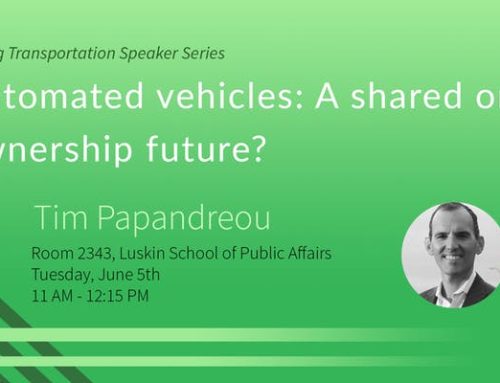The title of opening talk at the 24th annual Arrowhead symposium was brazen and even a touch combative: “What are Resilient Cities and Regions, and Why Should We Care?” In his introductory remarks, Symposium Director Brian Taylor quickly made clear the provocative tone was driven by urgency, since if resilience takes the form of a buzzword that means almost anything, then it may soon mean almost nothing. The central intellectual challenge of the symposium would thus be to apply this powerful yet elusive term in meaningful, concrete ways to the world of public policy and planning practice.
Opening speakers Aidan Hughes and Alexandra Norton proved well-suited to answering this challenge and both brought impressive backgrounds and vivid case studies to make the concept of resilience come alive. Aidan Hughes is Principal of the global planning consulting firm Arup, and his talk centered on how to construct a framework of resilience so that it applies to everyone. Hughes emphasized that if a city’s resilience is about its ability to perform and continue its systems in the face of a disruption, then the question needs to address whether the poor and vulnerable can survive and thrive despite the stresses and shocks they might encounter.
Hughes discussed a recent research project from his work that utilized primary and secondary data from cities across the world to develop a flexible resilience framework. He presented examples such as the city of Concepcion, Chile, where a level 8.8 earthquake in 2010 was followed by a “social earthquake” in the form of looting and arson that the mayor of the city said “affected our soul the most violently. “ On the other hand, in Cali, Colombia, a disruption of the water supply in 2012 that would have created significant social problems if left unchecked was successfully managed due to the strong social fabric present in the city. Both cases showcased the necessity for a holistic resilience that assists all people and not just those with the most economic and social resources.
Alexandra Norton works on resilience for the city of New Orleans, and in a talk that echoed Hughes’ theme of how to best help the least well-off, Norton offered a clear take home point: if we’re going to create resilient cities, we must simplify the recovery process from a major disruption. Norton strongly defended the effort to rebuild New Orleans due to its economic contribution to GDP in the form of off-shore oil and the fact that seafood from Louisiana supplies 30% of the total supply in the United States. Her talk then pivoted to the recovery process in New Orleans after hurricane Katrina in 2005. The answer, Norton believes, is not to pick up and give up, but to learn and adapt.
With respect to the specific case of new Orleans, the recovery effort focused on physical assets, physical needs, and putting people back to work, and according to Norton, there are lessons to be learned here. Investing in institutional infrastructure was overlooked, and as a result, organizational silos and poor communication channels ended up creating barriers between agencies and the people in need of aid and assistance. Communication channels were slow and unreliable, files were lost, personnel turnover was high, and a general disorganization pervaded the recovery process. Ultimately, responsibility for recovery often fell on individuals who had lost everything and were the least able to cope.
Norton asserted that the question then becomes how to plan for the need to navigate institutional complexity in response to a catastrophic event. Norton recommends a person-centered approach inspired by both technology and psychology. Processes should have clear, stable rules, applications should be short, easy to fill out, and the response time should be as short as possible. The overall lesson from New Orleans is to simplify and be adaptable, because successful resilience takes a nonlinear form based on continual improvements in the face of occasional setbacks.
-Summary by Anne Brown and Nate Holmes





